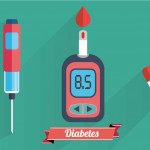
Act now to prevent diabetes epidemic
07-04-2016 | Posted By: Admin | 2258 View(s)
World Health Organisation (WHO) projects that diabetes will be the seventh leading cause of death in 2030
Diabetes is a chronic disease that occurs either when the pancreas does not produce enough insulin or when the body cannot effectively use the insulin it produces. Insulin is a hormone that regulates blood sugar. Hyperglycaemia, or raised blood sugar, is a common effect of uncontrolled diabetes and over time leads to serious damage to many of the body’s systems, especially the nerves and blood vessels.
In 2014 the global prevalence of diabetes epidemic was estimated to be 9% among adults aged 18 plus years. World Health Organisation (WHO) projects that diabetes will be the seventh leading cause of death in 2030. Act on diabetes now is the message of World Health Day being celebrated this year on April 7. Efforts to prevent and treat diabetes will be important to achieve the global Sustainable Development Goal target of reducing premature mortality from non-communicable diseases (NCDs) by one-third by 2030. Many sectors of society have a role to play, including governments, employers, educators, manufacturers, civil society, a private sector, the media and individuals themselves.
Diabetes can damage the heart, blood vessels, eyes, kidneys, and nerves. Combined with reduced blood flow, neuropathy (nerve damage) in the feet increases the chance of foot ulcers, infection and the eventual need for limb amputation. Diabetic retinopathy is also an important cause of blindness. One per cent of global blindness can be attributed to diabetes. And diabetes is among the leading causes of kidney failure.
Diabetes is of two types. Type 1 diabetes, previously known as insulin-dependent, juvenile or childhood-onset, is characterised by deficient insulin production and requires daily administration of insulin. The cause of type 1 diabetes is not known, and it is not preventable with current knowledge. Symptoms include excessive excretion of urine (polyuria), thirst (polydipsia), constant hunger, weight loss, vision changes and fatigue. These symptoms may occur suddenly.
Type 2 diabetes, formerly called non-insulin-dependent or adult-onset, results from the body’s ineffective use of insulin. Type 2 diabetes comprises 90% of people with diabetes around the world and is largely the result of excess body weight and physical inactivity. Its symptoms may be similar to those of Type 1 diabetes but are often less marked. As a result, the disease may be diagnosed several years after onset, once complications have already arisen. Gestational diabetes occurs during pregnancy, and these women are at increased risk of type 2 diabetes in the future. Gestational diabetes is diagnosed through prenatal screening, rather than reported symptoms. Meanwhile, people with impaired glucose tolerance (IGT) and impaired fasting glycaemia (IFG) are also at high risk of progressing to type 2 diabetes.
Simple lifestyle measures have been shown to be effective in preventing or delaying the onset of type 2 diabetes. To help prevent type 2 diabetes and its complications, people should achieve and maintain healthy body weight; be physically active by following at least 30 minutes of regular, moderate-intensity activity every day. More activity is required for weight control. One must eat a healthy diet of between 3 to 5 servings of fruits and vegetables a day and reduce sugar and saturated fats intake.
Inexpensive blood testing can help in early diagnosis of this killer disease. Treatment of diabetes involves lowering blood glucose and the levels of other known risk factors that damage blood vessels. Other costs saving interventions include screening and treatment for retinopathy (which causes blindness); blood lipid control (to regulate cholesterol levels); screening for early signs of diabetes-related kidney disease. These measures should be supported by a healthy diet, regular physical activity, maintaining normal body weight and avoiding tobacco use.
WHO aims to stimulate and support the adoption of effective measures for the surveillance, prevention and control of diabetes and its complications, particularly in low and middle-income countries. To this end, WHO provides scientific guidelines for diabetes prevention; it develops norms and standards for diabetes diagnosis and care; builds awareness on the global epidemic of diabetes; conducts surveillance of diabetes and its risk factors According to WHO there are 246 million people in the world living with diabetes. This is almost 6% of the world’s adult population. India is the diabetes capital of the world. It is estimated that currently there are 40 million people with diabetes in India and by 2025 this number will swell to 70 million. This would mean every fifth diabetic in the world would be an Indian.
If diabetes would continue to increase in the next 30 years at the same rate statistics show it has increased in the last 30 years, it would rival tuberculosis as a cause of death, and if this progress for another generation, diabetes would be responsible for almost the entire mortality of the world. Hence the need for quick and drastic action is the need of the hour.
With the IT era drastically changing the lifestyles of young people around the world, Indians with their strong IT capability and genetic susceptibility to type 2 diabetes, are more prone to developing this disorder below 30 years and even below age 15. We must act on diabetes now to tackle this silent epidemic.
Credit: Times of India










